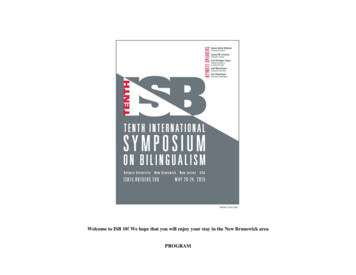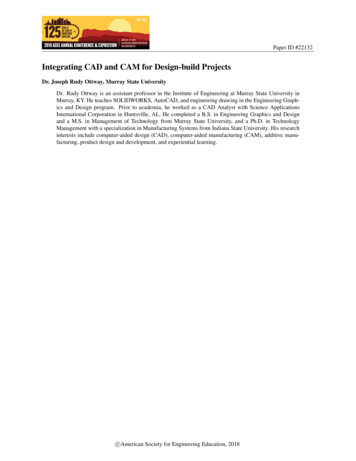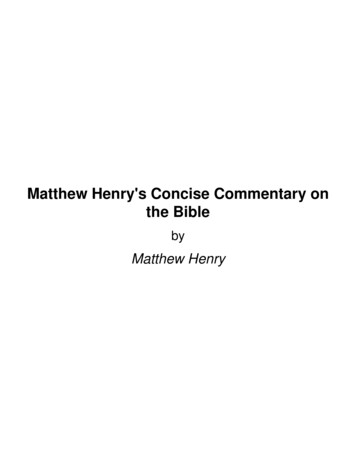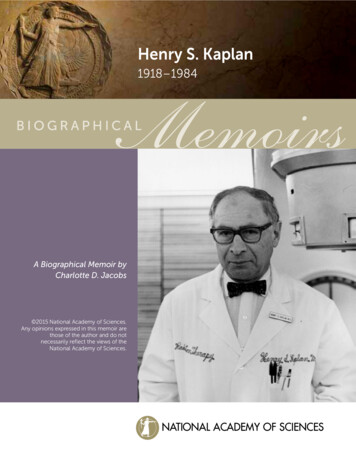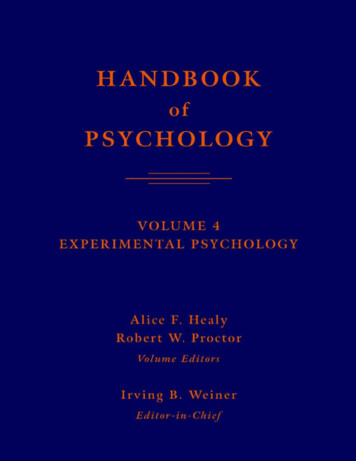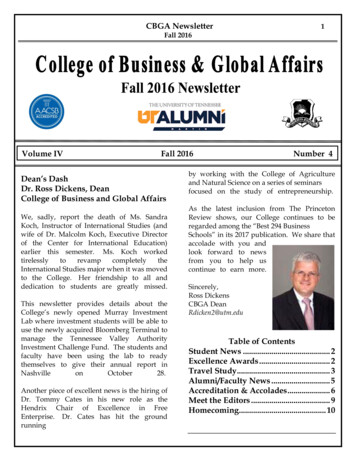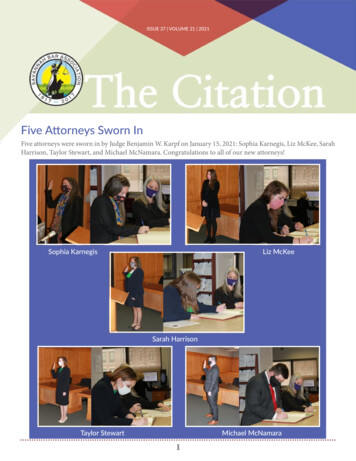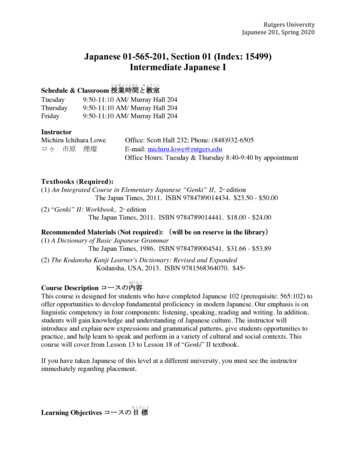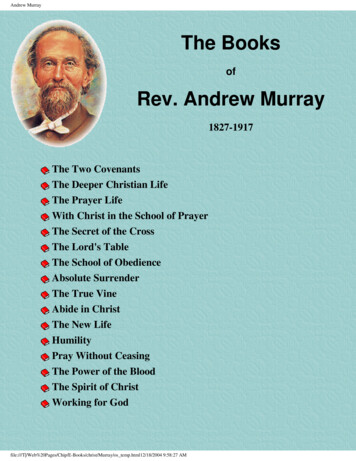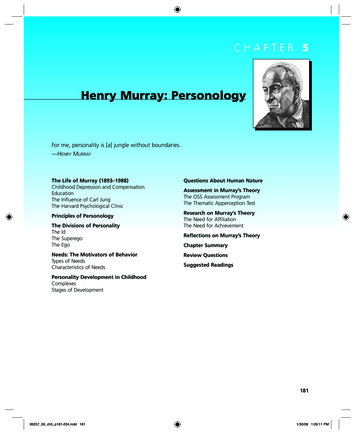
Transcription
CHAPTER 5Henry Murray: PersonologyFor me, personality is [a] jungle without boundaries.—HENRY MURRAYThe Life of Murray (1893–1988)Childhood Depression and CompensationEducationThe Influence of Carl JungThe Harvard Psychological ClinicPrinciples of PersonologyThe Divisions of PersonalityThe IdThe SuperegoThe EgoNeeds: The Motivators of BehaviorTypes of NeedsCharacteristics of NeedsQuestions About Human NatureAssessment in Murray’s TheoryThe OSS Assessment ProgramThe Thematic Apperception TestResearch on Murray’s TheoryThe Need for AffiliationThe Need for AchievementReflections on Murray’s TheoryChapter SummaryReview QuestionsSuggested ReadingsPersonality Development in ChildhoodComplexesStages of Development18106257 06 ch5 p181-204.indd 1811/30/08 1:09:11 PM
182PART TWOThe Neopsychoanalytic ApproachHenry Murray designed an approach to personality that includes conscious andunconscious forces; the influence of the past, present, and future; and the impact ofphysiological and sociological factors. The influence of Freudian psychoanalysis canbe seen in Murray’s recognition of the effect on adult behavior of childhood experiences and in his notions of the id, ego, and superego. Although Freud’s imprint isclear, Murray gave unique interpretations to these phenomena. His deviations fromorthodox psychoanalysis are so extensive that his system must be classified with theneo-Freudians rather than with the Freudian loyalists.Two distinctive features of Murray’s system are a sophisticated approach tohuman needs and the data source on which he based his theory. His proposed listof needs is still widely used in personality research and assessment and in clinicaltreatment. His data, unlike those of theorists discussed in earlier chapters, come fromso-called normal individuals (undergraduate male students at Harvard University)rather than from patients undergoing psychotherapy. Also, some of the data werederived from more empirically based laboratory procedures rather than from casehistories.Because of his long affiliation with a major university instead of relative isolation in a clinic or private practice, and because of his personal charisma, Murraygathered and trained a large number of psychologists, many of whom have sinceachieved prominence and carried on his teachings.The Life of Murray (1893–1988)Childhood Depression and CompensationHenry Murray’s childhood contained maternal rejection, elements of Adlerian compensation for a physical defect, and a supernormal sensitivity to the sufferings ofothers. Born into a wealthy family, Murray grew up in New York City, in a houseon what is now the site of Rockefeller Center. His summers were spent on a LongIsland beach. As a child, he accompanied his parents on four long trips to Europe.For the Adlerians among you, Murray reported that some of his earliest recollectionsfocused on his privileged background (Triplet, 1993).Another significant early memory is more intriguing. Murray called it “themarrow-of-my-being memory” (Murray, 1967, p. 299). At about age 4, he waslooking at a picture of a sad woman sitting next to her equally sad son. This wasthe same kind of gloomy picture Murray later used in his Thematic ApperceptionTest. Murray’s mother told him, “It is the prospect of death that has made them sad”(Murray, 1967, p. 299). Murray interpreted the memory as indicating the death ofhis emotional ties to his mother because she had abruptly weaned him when he was2 months old, preferring, he believed, to lavish her affection on his siblings. He insisted that his mother’s actions led to his lifelong depression, a condition that formedthe core of his personality.Murray referred to his depression as a source of “misery and melancholy” andhe attempted to mask it in everyday behavior by adopting an ebullient, cheerful, andoutgoing manner (Murray, 1967). This lack of a childhood attachment to his motherlater led Murray to question Freud’s Oedipus complex because it did not coincide06257 06 ch5 p181-204.indd 1821/29/08 5:18:19 PM
CHAPTER 5Henry Murray: Personology183with his own experiences. Another factor that made Murray sensitive to emotionalproblems and sufferings was his relationship with two emotionally disturbed aunts.Murray was afflicted with crossed eyes, and at the age of 9, he underwent anoperation that was performed in the dining room of his home. The condition wascorrected, but a slip of the surgeon’s blade left Murray with no stereoscopic vision.No matter how hard he tried, he was never able to succeed at games such as tennisor baseball because he could not focus both eyes on the ball. He remained unawareof his visual defect until he was in medical school, when a physician asked him if hehad had trouble playing sports as a child.Murray’s physical ineptness and a speech impediment (a stutter) drove him tocompensate for his limitations. When he tried to play football, he had to be quarterback, and when he was calling plays, he never stuttered. After being bested in aschoolyard fight, Murray took up boxing and won the local featherweight championship. He later agreed that “an Adlerian factor was at work” in these childhood effortsto compensate for his disabilities (Murray, 1967, p. 302).EducationAfter attending Groton, a preparatory school, Murray enrolled at Harvard University. He studied history but earned mediocre grades because he preferred “the threeRs— Rum, Rowing, and Romanticism” (Robinson, 1992, p. 27). His career followeda devious route to the study of personality. He disliked the psychology course hetook in college and dropped out after the second lecture. He did not attend anotherpsychology course until years later, when he taught one himself.In 1919, Murray graduated from Columbia University Medical School at thetop of his class. He also earned an M.A. in biology from Columbia and taughtphysiology at Harvard. He served a 2-year internship in surgery at a New Yorkhospital where he helped care for a future U.S. president, Franklin D. Roosevelt,who was suffering from polio. Following the internship, Murray spent 2 years atthe Rockefeller Institute conducting biomedical research in embryology. He wentabroad for further study and in 1927 received his Ph.D. in biochemistry from Cambridge University.The Influence of Carl JungMurray’s sensitivity and empathy toward others were reinforced during his internship, when he became interested in the psychological factors in his patients’ lives. In1923, he read Carl Jung’s book Psychological Types and found it fascinating. “I foundthis book at the medical school bookstore on the way home one night, and I read it allnight long and all the next day” (Murray quoted in Anderson, 1988, p. 147).A few weeks after finishing the book, Murray was faced with a serious personalproblem. He had fallen in love with Christiana Morgan, a beautiful, wealthy, depressive married woman who was also impressed by Jung’s work. Murray did not wantto leave his wife of 7 years—he claimed to abhor the idea of divorce—but neitherdid he want to give up his lover, whose spirited, artistic nature was the opposite ofhis wife’s. Murray insisted he needed both women.06257 06 ch5 p181-204.indd 1831/29/08 5:18:20 PM
184PART TWOThe Neopsychoanalytic ApproachHe lived with the conflict for 2 years until, at Christiana Morgan’s suggestion,he went to Zurich to meet with Carl Jung. The two men spent a month together, andJung was able to resolve Murray’s difficulty by instruction and example. Jung wasalso having an affair with a younger woman, a relationship he maintained openlywhile living with his wife. Jung counseled Murray to do the same, and Murray didso for the next 40 years.But first, the principal actors in this drama all found themselves in Zurich, withJung in the role of director. He decreed that Christiana Morgan’s husband shouldbe analyzed by Toni Wolff, who was Jung’s mistress. In addition, Jung spent manyhours with Christiana, analyzing her bizarre dreams and visions. Murray’s wife,Josephine, was reluctant to play her part. She spent 20 minutes listening to Junginsist that Murray needed to live with both his wife and his mistress and quicklydecided that Jung was a dirty old man (Robinson, 1992). In time, however, bothMurray’s wife and Morgan’s husband were persuaded to accept the affair.1The experience with Jung and the resolution of Murray’s marital dilemma turnedMurray toward a career in psychology. He had sought help for a personal problem,and psychology had provided an answer (Anderson, 1988). Thus, Jung did morethan resolve Murray’s personal and career dilemmas; he made Murray aware of thebreadth and impact of unconscious forces. Murray wrote, “The great floodgates ofthe wonder-world swung open. I had experienced the unconscious” (1940, p. 153).Murray’s attitude toward the man who helped him through his early criseschanged dramatically over the years. His initial acceptance of Jung’s views turnedto scathing dismissal. Murray later said that Jung would “believe anything I toldhim that was along the lines that he liked, but he would overlook what did not fit histheories” (quoted in Anderson, 1988, p. 155).The Harvard Psychological ClinicIn 1927, psychologist Morton Prince at the new Harvard Psychological Clinic,established specifically to study personality, offered Murray an appointment. A former student described the clinic as “wisteria on the outside, hysteria on the inside”(Smith, 1990, p. 537). As part of his training, Murray underwent orthodox Freudianpsychoanalysis and reported that his analyst became bored by the phlegmatic natureof his childhood and his lack of complexes. Murray recalled that the analyst had littleto say. The analyst’s stomach rumbled, and his office was “depressing, the color offeces, [a] miserable room enough to send a patient into a morbid phase” (quotedin Anderson, 1988, p. 159).In the 1930s, Murray and Morgan developed the Thematic ApperceptionTest (TAT), still one of the most widely used projective measures of personality(Morgan & Murray, 1935). For many years, it was thought that the TAT was primarily Murray’s work, but in 1985, Murray revealed that Morgan had done most of the106257 06 ch5 p181-204.indd 184Christiana Morgan, who at age 63 was described as “attractive, sultry, and mysterious,” drowned in2 feet of water off an island in the Caribbean. By that time, Murray was reported to be “rather disgustedwith her seemingly incurable alcoholism” and was already dating the woman he would marry after hisfirst wife died (Schneidman, 2001, pp. 291, 294).1/29/08 5:18:20 PM
CHAPTER 5Henry Murray: Personology185work to develop the test. Further, the original idea for the test had come from one ofhis women students (Bronstein, 1988, p. 64).The TAT became a best-seller for Harvard University Press. Despite the magnitude of Morgan’s contribution, her name was dropped from the publication, leavingMurray as sole author, an action taken with Murray’s agreement (Douglas, 1993).This decision seems inexcusable, given her importance in the development of the testand in much of Murray’s subsequent work. At age 94, long after Morgan’s death, heacknowledged that she was “part of every paper he wrote and every lecture he gave,and that her very presence at the clinic raised the caliber of his thinking” (Douglas,1993, p. 297).In 1938, Murray published Explorations in Personality: A Clinical andExperimental Study of Fifty Men of College Age. This book assured his almost instant success as a leading personality theorist. Now considered a classic, it boostedthe effort begun by Gordon Allport the year before to make the study of personalityan academically respectable part of American psychology.During World War II, Murray joined the U.S. Army and became director ofassessment for the Office of Strategic Services (the OSS, a forerunner of the CIA),screening candidates for dangerous assignments. He maintained an interest in literature, especially the work of Herman Melville, and in 1951 published an analysis ofthe psychological meaning of Melville’s novel Moby-Dick.Murray remained at Harvard until his retirement in 1962, conducting research,refining his personality theory, and training new generations of psychologists. Hereceived the American Psychological Foundation’s Gold Medal Award and the AmericanPsychological Association’s Distinguished Scientific Contribution Award.Although Murray lived to the age of 95, the debilitating effects of a strokemarred the last decade of his life. He came to view the sum of his career as a “seriesof failures and unfulfilled promises [and] could not escape the feeling that he hadnot quite made the grade” (Triplet, 1993, p. 386). At the end, as a biographer noted,Murray wascertainly willing to be done with life, though never to the point of losing his sense ofhumor. “I am dead,” he announced to his nurse. “No,” she replied, pinching him gentlyon the cheek; “see, you’re alive.” “I’m the doctor,” [he] snapped back, not without thehint of a smile—“I’m the doctor; you’re the nurse; and I’m dead.” Just days later, onThursday, June 23, he had his way. (Robinson, 1992, p. 370)Principles of PersonologypersonologyMurray’s system ofpersonality.06257 06 ch5 p181-204.indd 185The first principle in Murray’s personology, his term for the study of personality, isthat personality is rooted in the brain. The individual’s cerebral physiology guidesand governs every aspect of the personality. A simple example of this is that certaindrugs can alter the functioning of the brain, and so the personality. Everything onwhich personality depends exists in the brain, including feeling states, conscious andunconscious memories, beliefs, attitudes, fears, and values.A second principle in Murray’s system involves the idea of tension reduction.Murray agreed with Freud and other theorists that people act to reduce physiological1/29/08 5:18:20 PM
186PART TWOThe Neopsychoanalytic Approachand psychological tension, but this does not mean we strive for a tension-free state.It is the process of acting to reduce tension that is satisfying, according to Murray,rather than the attainment of a condition free of all tension.Murray believed that a tension-free existence is itself a source of distress. Weneed excitement, activity, and movement, all of which involve increasing, not decreasing, tension. We generate tension in order to have the satisfaction of reducingit. Murray believed the ideal state of human nature involves always having a certainlevel of tension to reduce.A third principle of Murray’s personology is that an individual’s personality continues to develop over time and is constructed of all the events that occur during the courseof that person’s life. Therefore, the study of a person’s past is of great importance.Murray’s fourth principle involves the idea that personality changes and progresses; it is not fixed or static.Fifth, Murray emphasized the uniqueness of each person while recognizingsimilarities among all people. As he saw it, an individual human being is like noother person, like some other people, and like every other person.The Divisions of PersonalityThe IdidTo Murray, the idcontains the primitive,amoral, and lustfulimpulses describedby Freud, but it alsocontains desirableimpulses, such asempathy and love.Murray divided personality into three parts, using the Freudian terms id, superego,and ego, but his concepts are not what Freud envisioned.Like Freud, Murray suggested that the id is the repository of all innate impulsivetendencies. As such, it provides energy and direction to behavior and is concernedwith motivation. The id contains the primitive, amoral, and lustful impulses Freuddescribed. However, in Murray’s personology system the id also encompasses innateimpulses that society considers acceptable and desirable.Here we see the influence of Jung’s shadow archetype, which has both good andbad aspects. The id contains the tendencies to empathy, imitation, and identification;forms of love other than lustful ones; and the tendency to master one’s environment.The strength or intensity of the id varies among individuals. For example, oneperson may possess more intense appetites and emotions than another. Therefore,the problem of controlling and directing the id forces is not the same for all peoplebecause some of us have greater id energy with which we must cope.The SuperegosuperegoTo Murray, the superegois shaped not only byparents and authorityfigures, but also by thepeer group and culture.06257 06 ch5 p181-204.indd 186Murray defined the superego as the internalization of the culture’s values and norms,by which rules we come to evaluate and judge our behavior and that of others. Thesubstance of the superego is imposed on children at an early age by their parents andother authority figures.Other factors may shape the superego, including one’s peer group and theculture’s literature and mythology. Thus, Murray deviated from Freud’s ideas byallowing for influences beyond the parent–child interaction. According to Murray,the superego is not rigidly crystallized by age 5, as Freud believed, but continues to1/29/08 5:18:21 PM
CHAPTER 5ego-idealA component of thesuperego that containsthe moral or idealbehaviors for which aperson should strive.egoTo Murray, theconscious organizerof behavior; this is abroader conception thanFreud’s.Henry Murray: Personology187develop throughout life, reflecting the greater complexity and sophistication of ourexperiences as we grow older.The superego is not in constant conflict with the id, as Freud proposed, becausethe id contains good forces as well as bad ones. Good forces do not have to be suppressed. The superego must try to thwart the socially unacceptable impulses, butit also functions to determine when, where, and how an acceptable need can beexpressed and satisfied.While the superego is developing, so is the ego-ideal, which provides us withlong-range goals for which to strive. The ego-ideal represents what we could becomeat our best and is the sum of our ambitions and aspirations.The EgoThe ego is the rational governor of the personality; it tries to modify or delay the id’sunacceptable impulses. Murray extended Freud’s formulation of the ego by proposing that the ego is the central organizer of behavior. It consciously reasons, decides,and wills the direction of behavior. Thus, the ego is more active in determiningbehavior than Freud believed. Not merely the servant of the id, the ego consciouslyplans courses of action. It functions not only to suppress id pleasure but also to fosterpleasure by organizing and directing the expression of acceptable id impulses.The ego is also the arbiter between the id and the superego and may favor oneover the other. For example, if the ego favors the id, it may direct the personality toward a life of crime. The ego may also integrate these two aspects of the personalityso that what we want to do (id) is in harmony with what society believes we shoulddo (superego).Opportunity exists in Murray’s system for conflict to arise between the id andthe superego. A strong ego can mediate effectively between the two, but a weak egoleaves the personality a battleground. Unlike Freud, however, Murray did not believethat this conflict was inevitable.Needs: The Motivators of BehaviorMurray’s most important contribution to theory and research in personality is his useof the concept of needs to explain the motivation and direction of behavior. He saidthat “motivation is the crux of the business and motivation always refers to something within the organism” (quoted in Robinson, 1992, p. 220).A need involves a physicochemical force in the brain that organizes and directsintellectual and perceptual abilities. Needs may arise either from internal processessuch as hunger or thirst, or from events in the environment. Needs arouse a levelof tension; the organism tries to reduce this tension by acting to satisfy the needs.Thus, needs energize and direct behavior. They activate behavior in the appropriatedirection to satisfy the needs.Murray’s research led him to formulate a list of 20 needs (Murray, 1938,pp. 144–145). Not every person has all of these needs. Over the course of your lifetimeyou may experience all these needs, or there may be some needs you never experience.Some needs support other needs, and some oppose other needs (see Table 5.1).06257 06 ch5 p181-204.indd 1871/29/08 5:18:21 PM
188PART TWOThe Neopsychoanalytic ApproachTable 5.1 Murray’s list of needsAbasementTo submit passively to external force. To accept injury, blame, criticism, and punishment. To become resigned to fate. To admit inferiority, error, wrongdoing, or defeat. To blame, belittle, or mutilate theself. To seek and enjoy pain, punishment, illness, and misfortune.To accomplish something difficult. To master, manipulate, or organizeAchievementphysical objects, human beings, or ideas. To overcome obstacles andattain a high standard. To rival and surpass others.To draw near and enjoyably cooperate or reciprocate with an alliedAffiliationother who resembles one or who likes one. To adhere and remainloyal to a friend.To overcome opposition forcefully. To fight, attack, injure, or kill anAggressionother. To maliciously belittle, censure, or ridicule another.To get free, shake off restraint, or break out of confinement. To resistAutonomycoercion and restriction. To be independent and free to act accordingto impulse. To defy conventions.To master or make up for a failure by restriving. To obliterate a humilCounteractioniation by resumed action. To overcome weaknesses and to repressfear. To search for obstacles and difficulties to overcome. To maintain self-respect and pride on a high level.To defend the self against assault, criticism, and blame. To conceal orDefendancejustify a misdeed, failure, or humiliation.To admire and support a superior other. To yield eagerly to the influDeferenceence of an allied other. To conform to custom.To control one’s environment. To influence or direct the behavior of othDominanceers by suggestion, seduction, persuasion, or command. To get othersto cooperate. To convince another of the rightness of one’s opinion.To make an impression. To be seen and heard. To excite, amaze, fasciExhibitionnate, entertain, shock, intrigue, amuse, or entice others.Harmavoidance To avoid pain, physical injury, illness, and death. To escape from adangerous situation. To take precautionary measures.To avoid humiliation. To quit embarrassing situations or to avoid conInfavoidanceditions that may lead to the scorn, derision, or indifference of others.To refrain from action because of the fear of failure.To give sympathy to and gratify the needs of a helpless other, an infantNurturanceor one who is weak, disabled, tired, inexperienced, infirm, humiliated, lonely, dejected, or mentally confused.To put things in order. To achieve cleanliness, arrangement, organizaOrdertion, balance, neatness, and precision.To act for fun, without further purpose.PlayTo exclude, abandon, expel, or remain indifferent to an inferior other.RejectionTo snub or jilt another.To seek and enjoy sensuous impressions.SentienceTo form and further an erotic relationship. To have sexual intercourse.SexTo be nursed, supported, sustained, surrounded, protected, loved, adSuccorancevised, guided, indulged, forgiven, or consoled. To remain close to adevoted protector.Understanding To be inclined to analyze events and to generalize. To discuss andargue and to emphasize reason and logic. To state one’s opinionsprecisely. To show interest in abstract formulations in science, mathematics, and philosophy.06257 06 ch5 p181-204.indd 1881/29/08 5:18:21 PM
CHAPTER 5 Henry Murray: Personology189Types of Needsprimary needsSurvival and related needsarising from internalbodily processes.secondary needsEmotional andpsychological needs,such as achievement andaffiliation.reactive needsNeeds that involve aresponse to a specificobject.proactive needsNeeds that arisespontaneously.Primary and secondary needs. Primary needs (viscerogenic needs) arise frominternal bodily states and include those needs required for survival (such as food,water, air, and harmavoidance), as well as such needs as sex and sentience. Secondary needs (psychogenic needs) arise indirectly from primary needs, in a way Murraydid not make clear, but they have no specifiable origin within the body. They arecalled secondary not because they are less important but because they develop afterthe primary needs. Secondary needs are concerned with emotional satisfaction andinclude most of the needs on Murray’s original list.Reactive and proactive needs. Reactive needs involve a response to somethingspecific in the environment and are aroused only when that object appears. Forexample, the harmavoidance need appears only when a threat is present. Proactiveneeds do not depend on the presence of a particular object. They are spontaneousneeds that elicit appropriate behavior whenever they are aroused, independent ofthe environment. For example, hungry people look for food to satisfy their need;they do not wait for a stimulus, such as a television ad for a hamburger, before acting to find food. Reactive needs involve a response to a specific object; proactiveneeds arise spontaneously.Characteristics of NeedsNeeds differ in terms of the urgency with which they impel behavior, a characteristic Murray called a need’s prepotency. For example, if the needs for air and waterare not satisfied, they come to dominate behavior, taking precedence over all otherneeds. Stock4B/Getty ImagesThe need for affectionis expressed incooperation, loyalty,and friendship.06257 06 ch5 p181-204.indd 1891/30/08 1:09:11 PM
190PART TWOThe Neopsychoanalytic ApproachsubsidiationTo Murray, a situationin which one need isactivated to aid in thesatisfaction of anotherneed.pressThe influence of theenvironment and pastevents on the currentactivation of a need.themaA combination of press(the environment) andneed (the personality)that brings order to ourbehavior.Some needs are complementary and can be satisfied by one behavior or a setof behaviors. Murray called this a fusion of needs. For instance, by working to acquire fame and wealth, we can satisfy the needs for achievement, dominance, andautonomy.The concept of subsidiation refers to a situation in which one need is activatedto aid in satisfying another need. For example, to satisfy the affiliation need by being in the company of other people, it may be necessary to act deferentially towardthem, thus invoking the deference need. In this case, the deference need is subsidiaryto the affiliation need.Murray recognized that childhood events can affect the development of specificneeds and, later in life, can activate those needs. He called this influence press because an environmental object or event presses or pressures the individual to act acertain way.Because of the possibility of interaction between need and press, Murray introduced the concept of thema (or unity thema). The thema combines personal factors(needs) with the environmental factors that pressure or compel our behavior (presses).The thema is formed through early childhood experiences and becomes a powerfulforce in determining personality. Largely unconscious, the thema relates needs andpresses in a pattern that gives coherence, unity, order, and uniqueness to our behavior.Personality Development in ChildhoodComplexescomplexTo Murray, a normalpattern of childhooddevelopment thatinfluences the adultpersonality; childhooddevelopmental stagesinclude the claustral,oral, anal, urethral, andgenital complexes.Drawing on Freud’s work, Murray divided childhood into five stages, each characterized by a pleasurable condition that is inevitably terminated by society’s demands.Each stage leaves its mark on our personality in the form of an unconscious complexthat directs our later development.According to Murray, everyone experiences these five complexes because everyone passes through the same developmental stages. There is nothing abnormalabout them except when they are manifested in the extreme, a condition that leavesthe person fixated at that stage. The personality is then unable to develop spontaneity and flexibility, a situation that interferes with the formation of the ego andsuperego. The stages of childhood and their corresponding complexes are shown inTable 5.2.Table 5.2 The childhood stages and complexes in Murray’s personology06257 06 ch5 p181-204.indd 190StageComplexThe secure existence within the wombThe sensuous enjoyment of sucking nourishmentwhile being heldThe pleasure resulting from defecationThe pleasure accompanying urinationGenital pleasuresClaustral complexesOral complexesAnal complexesUrethral complexGenital or castration complex1/29/08 5:18:23 PM
CHAPTER 5Henry Murray: Personology191Stages of DevelopmentThe claustral stage. The fetus in the womb is secure, serene, and dependent, condi-tions we may all occasionally wish to reinstate. The simple claustral complex is experienced as a desire to be in small, warm, dark places that are safe and secluded. Forexample, one might long to remain under the blankets instead of getting out of bedin the morning. People with this complex tend to be dependent on others, passive,and oriented toward safe, familiar behaviors that worked in the past. The insupportform of the claustral complex centers on feelings of insecurity and helplessness thatcause the person to fear open spaces, falling, drowning, fires, earthquakes, or simplyany situation involving novelty and change. The anti-claustral or egression form ofthe claustral complex is based on a need to escape from restraining womblike conditions. It includes a fear of suffocation and confinement and manifests itself in apreference for open spaces, fresh air, travel, movement, change, and novelty.The oral stage. The oral succorance complex features a combination of mouth activities, passive tende
Henry Murray: Personology For me, personality is [a] jungle without boundaries. —HENRY MURRAY The Life of Murray (1893–1988) Childhood Depression and Compensation Education The Infl uence of Carl Jung The Harvard Psychological Clinic Principles of Personology The Divisions of Personality The Id The Superego The Ego Needs: The Motivators of .File Size: 603KBPage Count: 24Explore further10 Important Psychological Concepts People Don't .www.psychologytoday.comCloser look at Henry A. Murray’s 'Explorations in .www.saybrook.eduThe Four Human Temperaments www.thetransformedsoul.comTHEORY OF PERSONOLOGY - The World of Psychologyilabpsychology.weebly.com8.4: Henry Murray and Personology - Social Sci LibreTextssocialsci.libretexts.orgRecommended to you b
